Evergreen: “The Godfather”
Last updated on 30 December 2020.
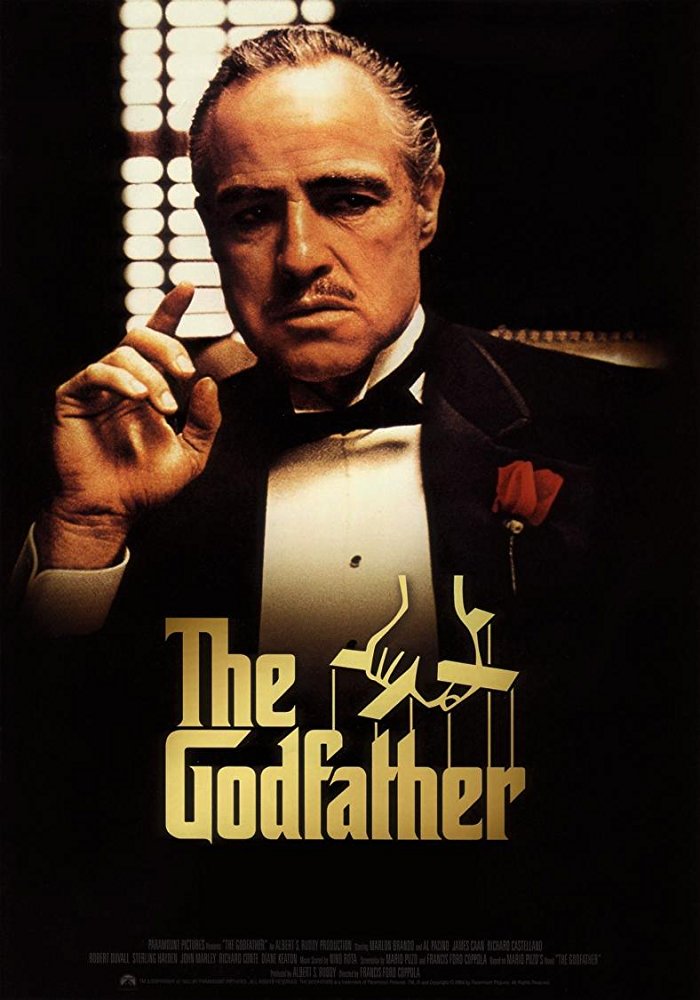

When I started this series of articles I had several goals. Of course, I want to tell people what I think are good movies or series, but if my only goal would be that, I’d just create a list and be done with it. So I also try to convey why I think these movies are worthy of your time, what makes them good. Bonus points if I can recommend a relatively unknown title, like Almost Famous or FLCL, or when I can shed some light on the background of a movie.
So with this instalment I’m starting at a severe disadvantage. Putting The Godfather in your Best Movies list is like saying “that Michelangelo dude knew what he was doing” or “those Beatles were kind of neat”. The movie is universally acclaimed and generally accepted as a great movie. It’s currently sitting at #2 in IMDb’s Top 250, has a 100% Metacritic rating (“universal acclaim”, indeed) and a 99% Fresh on Rotten Tomatoes.
Moreover, what else is there to be said about the movie, or its sequels, that hasn’t been said already? Entire libraries, nay, whole internets have been filled with articles and movies digging into every aspect of this movie, from its birth as a book by Mario Puzo, to its release, to the sequel, to the second sequel, to the saga’s restoration in 2008. Entire generations of film school students have been raised on a steady diet of Godfather analysis and dissection. What could I possibly add to that?
So, with your expectations suitably lowered, let’s go!
Background
The movie is based on Mario Puzo’s bestselling 1969 novel, and Paramount Pictures had already secured the rights to the book before it was even finished. That’s a lot of confidence in an unfinished product. Or it was desperation, as at this point the studio was reeling from a bunch of flops and a general downturn of the number of people going to the movies. In retrospect, not even US$100,000 for the book and the rights were a wise investment.At the time, it was risky because there was only a 60-page manuscript. Fortunately for Paramount, Puzo delivered and then some. The book was an enormous success in itself. It was a look at the Italian-American mob, chronicling the fortunes of a mafia family from the point of view of the family itself. Based on and/or inspired by real-life events, it depicted the gangster life in a sympathetic light. (Disclaimer: I’ve read the book but was years ago and I don’t remember its details.)
With the rights in hand, Paramount had to find a scriptwriter, a director and a cast. However, no director wanted to touch the property, partially because gang movies were out of fashion. (Fun fact: Sergio Leone was Paramount’s first choice but he declined as he had his own crime trilogy in mind: Once Upon a Time in America (1984).) Eventually Francis Ford Coppola was approached, a young and eager writer / director. He had just founded the studio American Zoetrope together with George Lucas in 1969, and (co-)written the screenplay for Patton. He initially didn’t want to do the movie as it represented everything about Hollywood he wanted to distance himself from: a big, sprawling project about sordid subject matter to be filmed in a classical, “studio” style. However, American Zoetrope was in bad shape and George Lucas urged him to do the movie so the studio could survive. Coppola agreed.
In the meanwhile, the novel’s enormous success had raised the stakes and everybody who was anybody in Paramount had suggestions and ideas on how this movie was going to be made — not least of which was the cast.
Marlon Brando was on the shortlist for the role of Vito Corleone, the titular Godfather, but he had a terrible reputation in Hollywood as a temperamental actor, difficult to work with. Paramount disapproved, Coppola had him screentest anyway, the big shots were impressed and “allowed Coppola to cast Brando for the role if Brando accepted a lower salary and put up a bond to ensure he would not cause any delays in production.” To me this reads as if Brando said “OK, I’ll be a good boy. No, really! Scout’s honour.”
Paramount had Robert Redford in mind for the role of the youngest son, Michael Corleone, the producer wanted somebody else, and Coppola wanted the then-unknown Al Pacino. (I’m reading here that Dustin Hoffman and Martin Sheen also auditioned for that part and oh boy, I’m having trouble imagining them in that role.) In the end, Coppola got his wish.
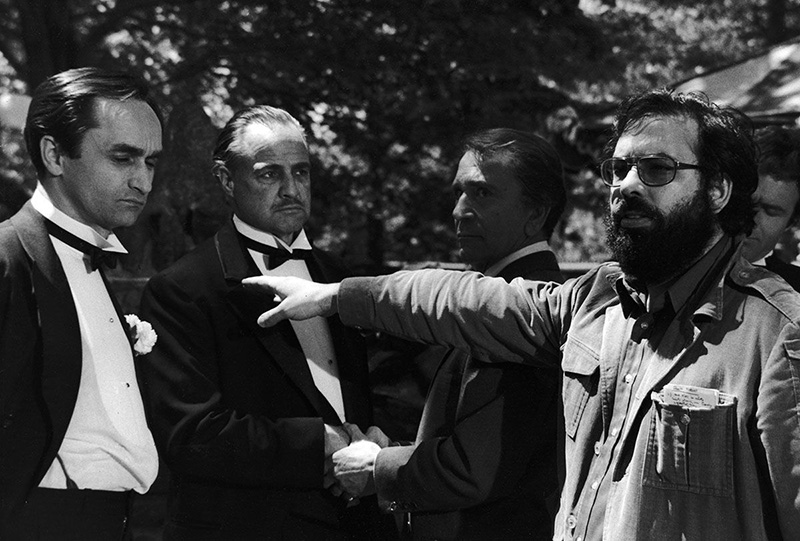
Digging through the history of The Godfather, listening to the commentary track of the movie and watching the features on the bonus disc, I can certainly find a theme. The deck really seemed stacked against Mr. Coppola. Throughout the movie’s troubled production he had issues and disagreements with the studio. He wanted to do things his way, and in the end he often got it — and the results speak for themselves. If you’d need an argument in favour of auteur theory, Coppola creating The Godfather and its sequels would serve.
(And if The Godfather was a tour de force, Coppola was going to top this with Apocalypse Now some years later. Go watch the documentary Hearts of Darkness: A Filmmaker’s Apocalypse (1991) and be amazed.)
Plot
Before rewatching the movie again, I had some vague memories about the script and the plot. In my recollection, The Godfather was rather intricate in its structure and its plot. I had the adjective “byzantine” primed and ready at my fingertips, but upon paying more attention, it’s actually not all that complicated.
The short-short version goes something like this:
Vito Corleone, “the Godfather”, is approached by a drug baron, Sollozzo, who wants to secure an investment from Vito in money and political protection. Vito declines. Sollozzo has Vito assassinated, but the Godfather survives.
Michael, Vito’s youngest son, goes to talk with Sollozzo and his policeman “bodyguard” and kills both.
Gang war erupts. Michael flees to Sicily where he will marry a local girl, while hot-headed eldest son Santino (Sonny) heads the family as the Godfather recuperates. Sonny is murdered. Michael’s Sicilian wife is blown up in a car bomb intended for him.
Vito takes back the reins of the family and makes a truce with his rivals. Michael returns home.
Vito suffers a heart attack. Michael takes up the mantle of the Godfather by brutally murdering all the family’s enemies.
(In this version, I didn’t refer to the Vegas plotline at all because in a way it doesn’t impact the main story at all. However, it is very important to the sequels.)
This economy of storytelling is displayed elsewhere, too: not everything is explained. What exactly is a consigliere? We’re never told, but apparently there’s a difference between a wartime consigliere and a peace-time one, and Sonny wants one and Tom Hagen is the other. Tom is part of the family, and yet he isn’t. Michael is supposed to be apart from the family business, but we don’t know exactly why. There are apparently Five Families in New York, but we’re not told what they are, what the Corleone’s place is within them or what their history is. This is the correct choice, because we don’t need to be told. We either can construct it from what is shown, or it doesn’t matter to the story. We don’t need to know who the Five Families are: we only need to know that Sollozzo wants the Godfather’s blessing for his drugs enterprise, even though he has the backing of a guy named Tattaglia.
Digging deeper
In fact, let’s dive into the first part of the movie, the opening scenes. It’s Connie’s wedding day and as she’s the daughter of Don Vito Corleone, it’s big thing with many guests.
In the opening scene, which I embedded above, we see the don talk to an undertaker called Bonasera. From this dialogue, we learn several things. Don Corleone wants respect and friendship. He operates under a kind of code (he doesn’t agree to kill the boys that abused Bonasera’s daughter as he asks). When Bonasera asks “How much shall I pay you?” he reacts disappointed and upset: “What have I ever done to treat me so disrespectfully?” He only agrees to help Bonasera when he asks: “Be my friend? … Godfather?” To Tom Hagen, after Bonasera leaves: “We’re not murderers, in spite of what this undertaker says.”
Then we shift to the garden, where the wedding is taking place, with hundreds of people in attendance. This signals that the family has money to spend, and that they have lots of friends, or at least people who think they should be there.
The family has been gathered for a group picture, but the Don resolutely calls it off because Michael isn’t there yet. Michael is important to him.
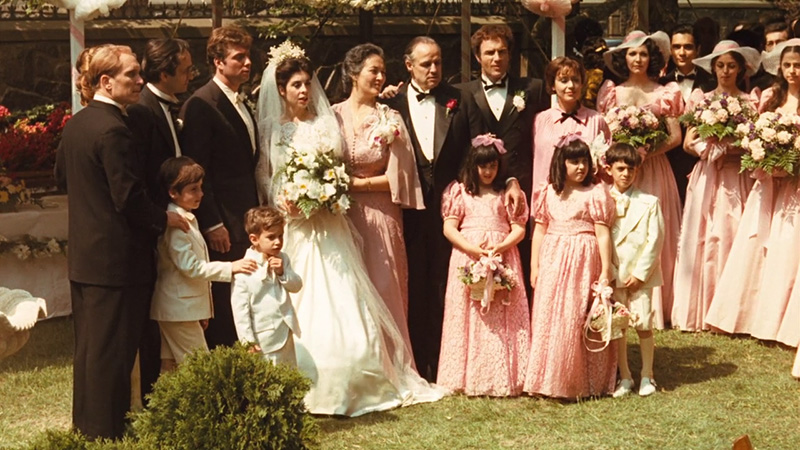
A man called Don Barzini joins the party and is shown deference by other guests. He orders that a wedding photographer, who was including him in a picture, get his camera destroyed — so apparently him being there can’t be allowed to be recorded.
Tom Hagen tells his wife that he has to go back to work: “No Sicilian can refuse any request on his daughter’s wedding day,” and he himself apparently is important to the Don’s business.
Sonny gets angry when some guys show up and take notes of the cars’ license plates. They turn out to be FBI agents and he can’t do anything about that, so instead he vents his frustration on another photographer passing by. Sonny is a temperamental man.
Vito Corleone and Tom have another audience, this time with a baker, Nazorine. Nazorine wants his daughter to marry an Italian boy who’s about to be forced back to Italy. This conversation goes much smoother than the one with Bonasera, and Don Corleone is complaisant in attitude. The baker doesn’t even wait for the Godfather to explicitly say he’ll help, it’s taken for granted. “Give it to a Jew congressman in another district”, so the Godfather has sway there.
I’ll stop here because I think the picture is clear by now. Many things are shown to us, or even explicitly mentioned, but there are a lot of things that we can glean from what is not told us.
Atmosphere
We’d almost forget it from my dry description, but this is all taking place during a big wedding. Business is conducted inside, in the dark, oppressive interior of the house, while outside, in the bright sun, the festivities take place. (Credit goes to this clip for pointing that out.) Thus the contrast of the family life with the “family business” is immediately introduced, and the loyalty to the family is indeed an important theme in the Godfather saga. As Vito himself says during the wedding, to his god-son, his adopted son and his womanizing eldest son: “Because a man who doesn’t spend time with his family can never be a real man.”
That wedding feels awfully real, a lively gathering with many people who may or may not behave. Coppola shows us small moments that demonstrate his eye for authenticity: the way a small girl is standing on top of the shoes of an older man to dance, the singing of a ribald song by a grandfather, the delight of Connie and Vito when Johnny Fontane arrives. Indeed, not only is the trilogy about family, it’s also about Coppola’s own family. He casted members of his family in important roles and drew upon his own experiences in an Italian-American family. These touches grant a level of verisimilitude to the movies that draws us in and keeps us interested. We don’t look away when these people conduct their gruesome business. Moreover, we feel for them and want them to succeed.
One of the things that made The Godfather “click” for Coppola was to think of it as a family history first, and a crime story second, and I think that is what led to the creation of a story that is still appealing nowadays. This year, it’s been forty years since the movie’s release and it barely shows its age. It still intrigues us.
Take the gun. Leave the cannoli.
I’m more than 2000 words into this article and didn’t even discuss the casting, the set design, the quotable lines or the music yet. To be honest, I’m running out of steam and what else could I say about these topics that hasn’t been said already?
What’s more I’ve seen the movie and its sequels so many times, I can’t imagine it in any other way. Those actors and actresses embody their parts: who else could ever play them? Who could imagine this movie without the characteristic, haunting theme music? We all know the strong lines, the quotes like the one that head this paragraph. So let’s leave it at this.
Further viewing
“What to watch if I like The Godfather?” is not a hard question to answer. Just go watch Part II, released a mere two years later. It’s one of the few sequels that is as good as its original, if not better. Indeed, it retroactively improves upon it, expanding the saga immensely. It has most of the original actors and crew gathered again, and they’re still on their A-game. Add to that Robert De NIro as a young Vito Corleone, and a intriguing storytelling structure with two storylines (about the young Vito, and a mature Michael Corleone) told in parallel, and you’ve got all the ingredients for another classic.
After that you might as well go all-in and watch Part III (1990). It’s not as good as its predecessors, but it still is a good movie. It’s just a tad disappointing as you’ll naturally compare it to the first two parts and it doesn’t reach those lofty heights. Nevertheless, I think it’s required viewing as it concludes the family saga, wraps up the tragedy that we’ve seen spinning out of control.
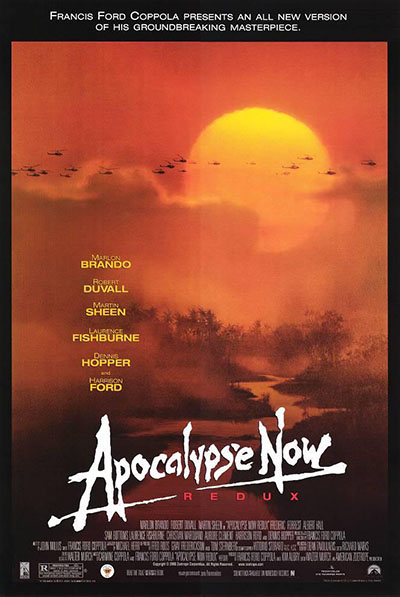

Francis Ford Coppola, in the meanwhile, didn’t actually direct that many movies that are well remembered, or that I will recommend here. Of course, I like Bram Stoker’s Dracula (1992), if only for its sumptuous visuals. The only real recommendation here goes to Apocalypse Now, the 1979 anti-war epic that would cement Coppola’s place in the annals of film if The Godfather hadn’t done it already. It depicts a man’s descent into the madness of the Vietnam war, and into his own madness. It’s a sprawling, meandering monster of a movie that would spawn its own documentary (the aforementioned Hearts of Darkness). Depending on the version you’re watching, you can look at two-and-a-half hours (standard version) or almost 200 minutes (Redux cut) of cinematographic excellence and acting prowess: Marlon Brando, Martin Sheen, Robert Duvall, Dennis Hopper, Harrison Ford and an under-age (!) Laurence Fishburne.
Then there’s the oeuvre of Al Pacino. At the time of The Godfather, he was only just starting out as a movie actor — he’d only done two movies before it. Not many people receive a Oscar nomination in their third movie. (He didn’t attend the ceremony, as he was nominated for Best Supporting Actor while he had more screen time than Brando. The latter won his award, but also didn’t attend and was represented by Sacheen Littlefeather, a Native American actress, and “[s]he clarified that Brando respectfully refused the award due to the poor treatment of American Indians in entertainment, as well as the recent Wounded Knee Incident.”)
Pacino would go on to play in movies like Dog Day Afternoon (1975), Scarface (1983), Frankie and Johnny (1991), Heat (1995), Donnie Brasco (1997), The Devil’s Advocate (1997), Insomnia (2002) and even Gigli (2003). There’s a reason I included the latter as it seems to me that these days he only appears in cameos or roles that are caricatures of his earlier performances, much to my dismay.
As for the gangster movie genre, there’s an enormous wealth there as well. Obviously The Godfather casts a long shadow and I don’t think any movie depicting (American) organised crime afterwards isn’t influenced in a way. I already mentioned Scarface and Donnie Brasco, but there’s of course Once Upon a Time in America (1984) (the reason Leone turned down directing The Godfather), The Untouchables (1987), Goodfellas (1990) (like Once Upon… and The Untouchables with De Niro) and The Departed (2006).
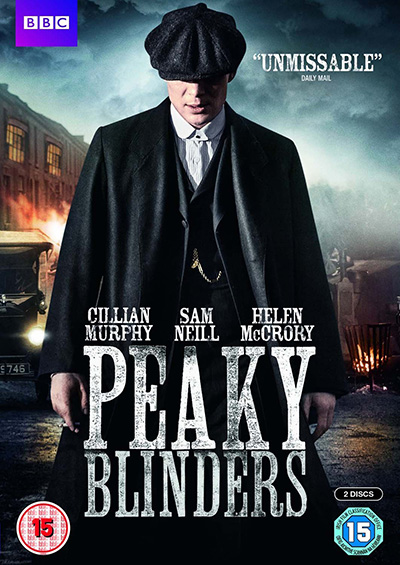

While of these movies are good examples of crime movies, none of these actually focus on the family aspect that’s so integral to The Godfather. For this, I recommend the recent BBC series Peaky Blinders. To quote myself: “It might be a case of "style over substance" in a very un-BBC-like way, but this family drama / gangster story set in post-Great War Birmingham has it all. Great acting (Cillian Murphy is mesmerising, most of the supporting cast is nailing it), beautiful sets and cinematography (as you’d expect from the BBC), killer soundtrack.”
